| Habsi Gumbaz | |
|---|---|
 |
Habsi Gumbaz or Saudagar Gumbaz is a tomb located on the outskirts of Junnar. It is listed as a monument of national importance.
| Habsi Gumbaz | |
|---|---|
 |
Habsi Gumbaz or Saudagar Gumbaz is a tomb located on the outskirts of Junnar. It is listed as a monument of national importance.
The date of the construction of the tomb is not known. However, Pushkar Sohoni states that it must be one of the earliest structures built by the Nizam Shahis. [1]

The tomb has a square plan. It is built out of dressed stone blocks, held in place by lime mortar. Stucco is used for ornamentation. On each side, there are three large arches at the bottom, and five smaller arches at the top. The entrance is through the middle arch on the southern side. Over the entrance is an inscription relating to Shia beliefs. It is topped by a large dome. [1]
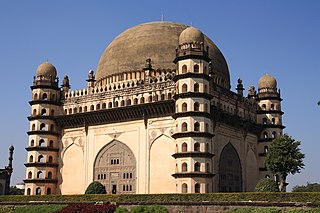
Gol Gumbaz, also written Gol Gumbad, is a 17th-century mausoleum located in Bijapur, a city in Karnataka, India. It houses the remains of Mohammad Adil Shah, seventh sultan of the Adil Shahi dynasty, and some of his relatives. Begun in the mid-17th century, the structure never reached completion. The mausoleum is notable for its scale and exceptionally large dome. The structure is an important example of Adil Shahi architecture.
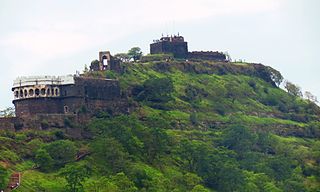
Daulatabad Fort, originally Deogiri Fort, is a historic fortified citadel located in Daulatabad village near Chhatrapati Sambhaji Nagar, Maharashtra, India. It was the capital of the Yadavas, for a brief time the capital of the Delhi Sultanate (1327–1334), and later a secondary capital of the Ahmadnagar Sultanate (1499–1636).
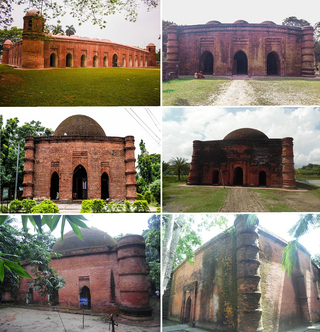
The Mosque City of Bagerhat is a UNESCO World Heritage Site in Bagerhat District, Bangladesh. It contains 360 mosques, public buildings, mausoleums, bridges, roads, water tanks and other public buildings constructed from baked brick. The mosques were built during the Bengal Sultanate in the 15th century, of which the Sixty Dome Mosque is the largest. Other mosques include the Singar Mosque, the Nine Dome Mosque, the Tomb of Khan Jahan, the Bibi Begni Mosque and the Ronvijoypur Mosque. The mosques were built during the governorship of Ulugh Khan Jahan, a Turkic military officer appointed as governor in the Sundarbans by Sultan Mahmud Shah of Bengal.
Sohna is a town and a municipal council in the Gurugram district of Haryana, India. A popular tourist weekend and conference retreat, it is on the highway from Gurugram to Alwar near a vertical rock. Sohna is known for its hot springs and Shiva temple. Major communities in Sohna are Gurjars, Meo, Ahir, Rajput and jaat]]. Gurugram district is divided into 4 sub-divisions each headed by a Sub-Divisional Magistrate (SDM): Gurugram, Sohna, Pataudi and Badshahpur.
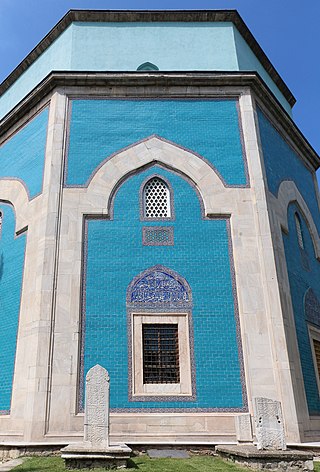
The Green Tomb is a mausoleum of the fifth Ottoman Sultan, Mehmed I, in Bursa, Turkey. It was built by Mehmed's son and successor Murad II following the death of the sovereign in 1421. The architect Hacı Ivaz Pasha designed the tomb and the Yeşil Mosque opposite to it.

The Sultanate of Ahmednagar was a late medieval Indian Muslim kingdom located in the northwestern Deccan, between the sultanates of Gujarat and Bijapur, ruled by the Nizam Shahi dynasty. It was established when Malik Ahmed, the Bahmani governor of Junnar, after defeating the Bahmani army led by general Jahangir Khan on 28 May 1490, declared independence and established the Ahmadnagar Sultanate.

The Katra Masjid is a former caravanserai, mosque and the tomb of Nawab Murshid Quli Khan. It was built between 1723 and 1724. It is one of the largest caravanserais in the Indian subcontinent. It was built during the 18th century, when the early modern Bengal Subah was a major hub of trade in Eurasia. The Katra Masjid is located in the north eastern side of the city of Murshidabad, in the Indian state of West Bengal. The most striking feature of the structure are the two large corner towers having loopholes for musketry.
Mirali mausoleum is a historical and architectural monument located near the necropolis dating back to the Middle Ages between the Kurdlar and Ashaghi Veysalli villages in the Fuzuli district. There is no information about whom the monument is dedicated to, who the architect and commissioner are, and the exact construction date. The monument was included in the list of nationally significant immovable historical and cultural monuments by the decision of the Cabinet of Azerbaijan on August 2, 2001, with the number 132.

The Lila Gumbaj Ki Mosque is a former mosque, now a heritage site, located in Champaner, in the state of Gujarat, India. The mosque is a Monument of National Importance, and, together with other structures, is part of the Champaner-Pavagadh Archaeological Park, a UNESCO World Heritage Site, and is among the 114 monuments there which are listed by the Baroda Heritage Trust. It is located near the east gate of the former city.

Domes first appeared in South Asia during medieval period when it was constructed with stone, brick and mortar, and iron dowels and cramps. Centering was made from timber and bamboo. The use of iron cramps to join together adjacent stones was known in Ancient India, and was used at the base of domes for hoop reinforcement. The synthesis of styles created by this introduction of new forms to the Hindu tradition of trabeate construction created a distinctive architecture.
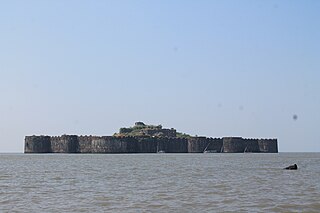
The Deccan sultanates were five early modern kingdoms, namely Bijapur, Golkonda, Ahmadnagar, Bidar, and Berar, which ruled the Deccan Plateau for part of the 15th, and the majority of the 16th–17th centuries. Their architecture was a regional variant of Indo-Islamic architecture, and influenced by the styles of the Delhi Sultanate and later Mughal architecture, but sometimes also influenced from Persia and Central Asia. Hindu temple architecture in the same areas had very different styles.

The Gumbaz at Ganjam Srirangapattana is a Islamic mausoleum located in centre of a beautiful landscaped gardens, holding the graves of Tipu Sultan, his father Hyder Ali (Middle) and his mother Fakhr-Un-Nisa. It was built by Tipu Sultan to house the graves of his parents. Tipu was buried here after his death in the Siege of Srirangapatna in 1799.
Pushkar Sohoni is an architect, and an architectural and cultural historian. He is an associate professor in the department of Humanities and Social Sciences at the Indian Institute of Science Education and Research, Pune. He was Chair of the department from 2019 to 2024.
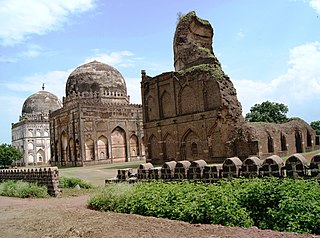
The Bahmani tombs complex at Bidar is the necropolis of the Bahmani dynasty, located in Bidar, in the Indian state of Karnataka.
The Battle of Bhatvadi was fought in 1624, near modern Bhatodi Pargaon village in Maharashtra, India. The Ahmadnagar army led by Malik Ambar defeated a combined Mughal-Bijapur force led by the Bijapuri general Mullah Muhammad Lari.

Qila-e-Ark is a 17th-century palace/citadel complex in Aurangabad, Maharashtra. Built by Mughal emperor Aurangzeb when he was a prince, it served as his royal residence during his subsequent reign as emperor. The site is currently ruined, and has no legal protected status; several modern-day buildings also encroach the complex. Notable surviving structures include a royal mosque, and a palatial building.

The Haft Gumbaz, also spelt Haft Gumbad are a group of tombs of the Bahmani dynasty situated in Kalaburagi, in the Indian state of Karnataka. Built during the 14th and 15th centuries, the tombs are examples of early Indo-Islamic architecture. There are seven tombs in total, with four being tombs of the rulers of the Bahmani dynasty. The tomb complex is a monument of national importance, maintained by the Archeological Survey of India. The tomb complex is part of the "Monuments and Forts of the Deccan Sultanate", which is an ensemble of various structures added to the tentative list of the UNESCO World Heritage Sites.

The Tomb of Malik Ambar is a mausoleum located in Khuldabad, in the Indian state of Maharashtra. It is the burial place of Malik Ambar, a military leader who served as the prime minister of the Ahmadnagar Sultanate. Ambar built the tomb for himself, and was interred here upon his death in 1626. It is listed as a monument of national importance.

Kuk Gumbaz Mosque is an architectural monument in the city of Qarshi, Qashqadaryo Region, Uzbekistan. By the decision of the President of the Republic of Uzbekistan on 19 December 2018, the Khojash Mahram Madrasah was included in the national list of real estate objects of tangible cultural heritage and received state protection.
Dilawar Khan's Tomb and Mosque are located at Khed, in the Indian state of Maharashtra. They are located in a walled complex, Both the tomb and mosque are listed as monuments of national importance.